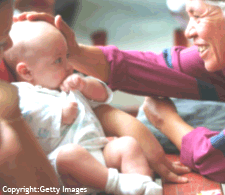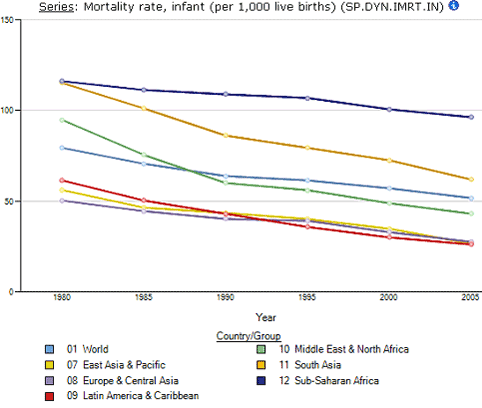Impact
 Child and infant mortality rates are sensitive indicators not only of child health, but also the general well-being of a society.
Child and infant mortality rates are sensitive indicators not only of child health, but also the general well-being of a society.
Infant mortality rates, in particular, reflect the attention paid to the health of mothers and newborns as well as the effectiveness of health systems.
Child mortality is seen as an important barometer of the effect of wider economic and social conditions on child heath. It measures an outcome of the development process rather than an input (such as expenditure on health). It is also known to result from a wide variety of factors such as the availability of maternal and child health services (including prenatal care), the level of immunisation, income and food availability in the family, and the availability of safe drinking water and basic sanitation.
Most deaths of children under five years are attributable to acute respiratory infections (mostly pneumonia), diarrhoea, malaria, measles, HIV/AIDS and neonatal conditions. Malnutrition is the largest contributor to child mortality, present in half of all cases.
Definitions and sources
Infant mortality rate is defined as the number of infants dying before reaching one year of age, per 1,000 live births in a given year.
Child mortality is defined as the number of infants dying before reaching five years of age, per 1,000 live births in a given year.
Mortality rates are produced from the harmonised estimates of the World Health Organization, The United Nations Children’s Fund (UNICEF), and the World Bank, based mainly on household surveys, censuses, and vital registration, supplemented by World Bank estimates based on household surveys and vital registration.
Long term trends
In the long term, UNICEF reports, there has been significant improvement in child survival with a 60 per cent fall in global child mortality rates since 1960 (State of the World’s Children 2008, UNICEF, 2008). However the variation between countries remains enormous, with mortality rates in the worst performing countries several hundred times those of developed countries.
Increasing age of motherhood and the use of fertility treatments in developed countries have resulted in infant mortality rates in countries with historically very low rates, such as Sweden, levelling off or even increasing in recent years.
How comparable are the data?
Some of the international variation in infant mortality can be attributed to differences in defining a ‘live’ birth. In developed countries, perinatal deaths (deaths occurring in the first four weeks) account for up to two thirds of all infant mortality. This means that the definition of a live birth can significantly affect the infant mortality rate. In several countries such as the US and Canada, all births are counted as live if they show any sign of life, regardless of pre-maturity or size. This includes births that other countries may define as ‘still born’ and tends to skew the mortality rates upwards. In contrast, former Soviet Republic countries, for example Belarus and Russia, tend to exclude very small babies born alive, but with less that 28 weeks gestation and who die within seven days of birth.
Data for countries with less developed health care systems sometimes only count births that take place in hospitals and health centres. Oman is one example. These types of variations on definitions are typically highlighted by footnotes within the data
Finding data on infant and child mortality
The following databanks can be used to assist in the study of child mortality. Access to these databases is free for the UK academic community through the UK Data Service.
The World Bank’s World Development Indicators contain global annual time series data on child and infant mortality for over 200 countries and 18 regional groups running from 1960 up until the latest available year. Reducing child mortality is one of the eight UN Millennium Development Goals, and the World Development Indicators is the source database used by policymakers to measure individual country progress against the overall target of cutting the mortality of under-fives by two-thirds by 2015.
Eurostat New Cronos provides comparative time series data on infant and child mortality for European countries, regions, cities and urban zones.
The UN Common Database contains tables that disaggregate child and infant deaths by gender and age, and can be used to examine the differences in child mortality rates between urban and rural areas. The data are annual time series and cover all countries from the 1960s onwards. Quinquennial estimates and projections of child and infant mortality rates for all countries up to the year 2050 can also be found in this database.

For further information or to access the datasets referred to in this case study see:
.
